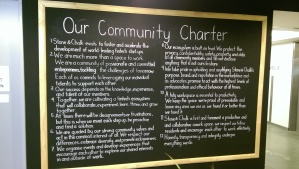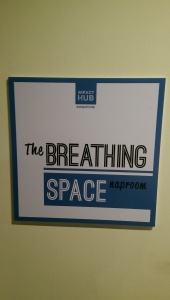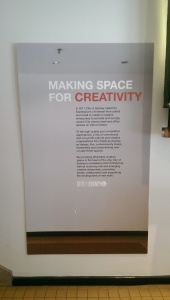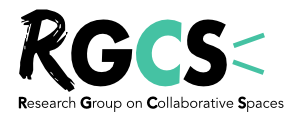I am just back from a trip in Singapore and Sydney which has been an opportunity to visit 15 collaborative spaces (e.g. coworking spaces, fab lab and maker spaces).
What a strange feeling… going so far, and feeling so close to what I already know.
Firstly, feeling so close to what I have seen in France and other countries. Same pieces of furniture (post-its, acoustic bubbles, iconic ping-pong tables, chalk boards, Ikea seats and tables…), same space design (welcome desk, general L or U shape of the place…), same emphasis on a ‘community’ (see the charter of Stone & Chalk below), general use of open spaces punctuated sometimes by small closed offices…

- Picture 1: The community charter of Stone & Chalk in Sydney
This makes me realize, again, how global our world has become. People share the same information, the same training (e.g. standardized MBA programs), the same providers and partly the same problems (cost of real estate in big cities, economic competition, need for more sustainable development…). Beyond these general trends, I also notice the same niche market, with a focus for some on gender positions (e.g. with Ventura in Sydney), entrepreneurs in digital areas and communication (for collective works in Singapore), academic labs (with SMU lab in Singapore) or fintech (with Stone & Chalk or Blue Chili in Sydney). Same buzzwords than in Paris or London. The presence of international networks (e.g. Impact hub Singapore) and the emergence of global social movements (notably coworking and maker movements) probably reinforce this impression of globalism. Visiting Impact hub (again…) was interesting. In spite of some unusual artifacts (e.g. the breathing room or the skype booth), the all place sounded extremely familiar.


- Pictures 2 and 3: The breathing room and Skype booth at Impact Hub Singapore
Then, I found very interesting the closeness in space of the places I visited. Again, most of them agglomerated in convergent areas (like in Paris). In Singapore, the choices are partly related to more centralized public policies and specialized areas (whereas Sydney is probably more market driven). Sometimes, an all eco-system could be visible on a coherent territory (e.g. several shops related to the maker movement on Oxford street in Sydney) or campus (with fab lab Singapore distributed on several sites of the campus of Singapore polytechnique).
Lastly, all these space are extremely close to each other in their communication practices. Websites (and their graphics) are often strangely similar. Tours (by space managers, community managers, interns or members of the space) are a key way to show, perform and materialize the service. Communities are always central in the promise. For sure, you will join a space, but you will also ‘join a community’, a family. Trust me, people help each other, and live cool time with each other. And beyond that (this was clear for Impact hub), you will also join a network, a place to connect. And the events organized by the place will play a central role in all this.
To conclude, I want also to emphasize a difference between Paris and the two cities. Obviously, fab labs and maker spaces were less present than for Paris or London. In Sydney numerous maker spaces exist (e.g. solidifier), but not at the same scale than Paris), in spite of a major public move towards creativity in 2011 (see picture below).

- Picture 4: Making space for creativity in Sydney
In Singapore, only one chartered fab lab is available (Fab lab Singapore of Singapore polytechnique university). It is part of the fab lab academy, and is located on a big campus. It took me time to join the place. As usual, I got lost 🙂 Is there a better way to understand an environment? Strangely, very few people I met and asked my way to knew the fab lab… even people sharing the same building. But I’ve been impressed by the tools, facilities and ambitions of the place (expanding through several sites on the campus). Clearly, this was supported by the university and strong public policies in these innovative directions. Beyond that, I identified very few maker spaces in Singapore (between 5 and 8, depending on the way one defines a maker space). Same for Sydney (compared to Paris), I identified very few spaces (in particular in the area of the city center). What does it mean? That the two global cities are ‘late’? Or less involved in the maker movement? Not sure that the idea of ‘being’ late makes sense. Both Singapore and Sydney corresponds to dynamic, innovative environments. Is it related to their more service oriented economy? Or a weaker development of engineering schools and engineering activites? Again, I am not really convinced by this idea. Weaker connections with the US trends? Both countries have strong connections with the Anglo-Saxon world in general and the US in particular. A lack of support of public policy? Many other cities have experienced the rise of the maker movement with a very modest involvement of public policies. Today, for the time being, all this remains partly a mystery. When the jet lag will be over, I will think again about all this, and maybe I will have clearer ideas in this issue.
FdV
PS: Thank you very much to Baptiste, Chloé, Merielle and Cindy for their precious help in the visit of collaborative spaces in Singapore. Thanks a lot to Steven for the tour of Fab lab Singapore, and Ted for the visit of SMU lab. Thank you very much to Julie, Anthony and Anouk for sharing very interesting visits in Sydney. A more detailed report of these visits will be available on the Stample community of RGCS London WG.
